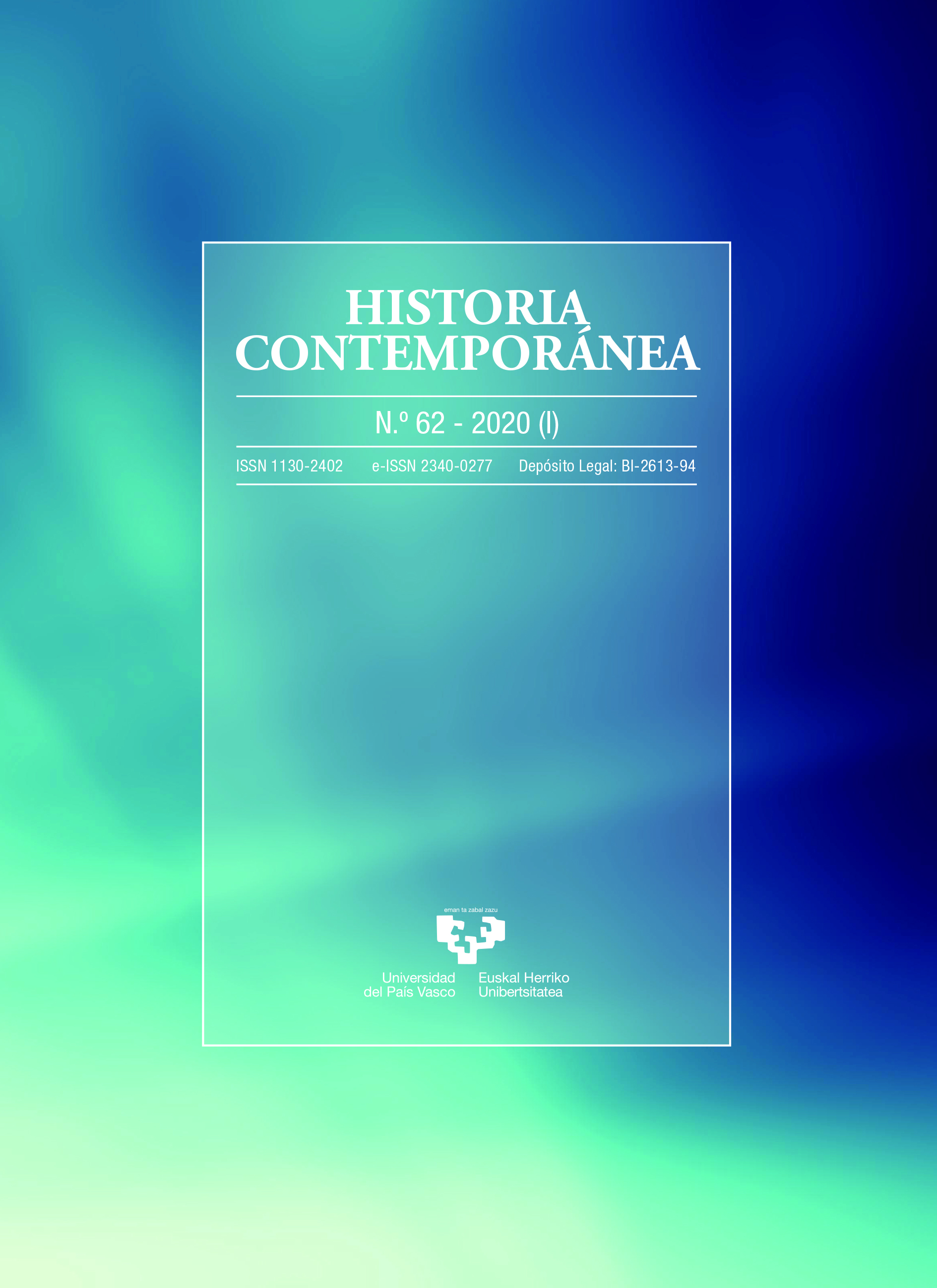The Birth of the Red Dynasty: The Establishment of Hereditary Succession in North Korea (1970-1974)
##plugins.themes.bootstrap3.article.main##
##plugins.themes.bootstrap3.article.sidebar##
Abstract
The establishment of a transmission of power from father to son was a decisive moment in the communist regime of Pyongyang and is a unique case in the history of Marxist political systems. The hereditary succession within the same family has its origin in the complex political development of communist North Korea and especially the emergence of a power structure associated with the figure of Kim Il Sung. The absence of a strong communist party to confront supreme leader's absolute power, the despotism of a small group of leaders and an unattractive international background favored the appointment of Kim Jong Il as his father's heir.
##plugins.themes.bootstrap3.article.details##
North Korea, hereditary succession, Kim Il Sung, Kim Jong Il, Korean Worker´s Party
AN, Tai Sung, North Korea in Transition: From Dictatorship to Dynasty, Greenwood Press, Westport, 1983.
BIALER, Seweryn, Stalin's Successors: Leadership, Stability, and Change in the Soviet Union, Cambridge University Press, Cambridge, 1980.
BROWNLEE, Jason, «Hereditary Succession in Modern Autocracies», World Politics, vol. 59, nº 4, 2007, pp. 595-628.
CHA, John H., y SOHN, K.J., Exit Emperor Kim Jong-Il: Notes from his Former Mentor, Abbott Press, Bloomington, 2012.
CHEONG, Seong-Chang, «Stalinism and Kimilsungism: A Comparative Analysis of Ideology and Power», Asian Perspective, vol. 23, nº 1, 2000, pp. 133-161.
COTTON, James, «The Prospects for the North Korean Political Succession», Korea & World Affairs, vol. 11, nº 4, 1987, pp. 745-768.
FLPH Editorial Board, Kim Jong Il: Short Biography, Foreign Languages Publishing House, Pyongyang, 2001.
GRZELCZYK, Virginie, «In the Name of the Father, Son, and Grandson: Succession Patterns and the Kim Dynasty», The Journal of Northeast Asian History, vol. 9, nº 2, 2012, pp. 33-68.
HERZ, John H., «The Problem of Successorship in Dictatorial Régimes: A Study in Comparative Law and Institutions», The Journal of Politics, vol. 14, nº 1, 1952, pp. 19-40.
JENCKS, Harlan W., «The Party, the Gun and the Great Leader: Civil-Military Relations in North Korea», en SCALAPINO, Robert A., y KIM Dalchoong (coord.), Asian Communism: Continuity and Transition, University of California Press, Berkeley, 1988, pp. 187-217.
KIM, Hakjoon, Dynasty: The Hereditary Succession Politics of North Korea, The Walter H. Shorenstein Asia-Pacific Research Center, Stanford, 2015.
KIM, Il Sung, Report on the Work of the Central Commmittee to the Fifth Congress of the Workers' Party of Korea (November 2, 1970), Foreign Languages Publishing House, Pyongyang, 1970.
KIM, Il Sung, Kim Il Sung Works. Volume 26: January-December 1971, Foreign Languages Publishing House, Pyongyang, 1986.
KIM, Sung Chull, North Korea under Kim Jong Il: From Consolidation to Systemic Dissonance, State University of New York, Albany, 2006.
KIM, Young C., «North Korea in 1974», Asian Survey, vol. 15, nº 1, 1975, pp. 43-52.
KIM, Zong Il [Jong Il], El arte cinematográfico, Ediciones en Lenguas Extranjeras, Pyongyang, 1989.
LEVI, Nicolas, «A Biography of Kim Pyong-il, the Second Dauphin?», Parallax, vol. 7, nº 1, 2010, pp. 33-46.
LEE, Chong-Sik, Korean Workers's Party: A Short History, Hoover Institution Press, Stanford, 1978.
LEE, Chong-Sik, «The Evolution of the Korean Workers' Party and the Rise of Kim Chong-il», en SCALAPINO, Robert A., y KIM, Jung-Yop (coord.), North Korea Today: Strategic and Domestic Issues, Berkeley: University of California Press, Berkeley, 1983, pp. 65-80.
LEE, Dong-Bok, «North Korea and Its Succession Issue», Korea & World Affairs, vol. 1, nº 1, 1977, pp. 48-66.
LI, Sok-ho, «The Role of the Military in North Korea's Political Power Succession (II)», Vantage Point, vol. 12, º 1, 1989, pp. 1-11.
LIM, Jae-Cheon, Kim Jong Il's Leadership of North Korea, Routledge, Nueva York, 2009.
MEISNER, Maurice, Mao's China and After: A History of the People's Republic, The Free Press, Nueva York, 1999.
OH, Kongdan, Leadership Change in North Korean Politics: The Succession to Kim Il Sung, RAND, Santa Monica, 1988.
SANDSCHNEIDER, Eberhard, «Political Succession in the People's Republic of China», Asian Survey, vol. 25, nº 6, 1985, pp. 638-658.
SCALAPINO, Robert A., y LEE, Chong-Sik, Communism in Korea. Part I: The Movement, University of California Press, Berkeley, 1972.
Socialist Constitution of the Democratic People's Republic of Korea, Foreign Languages Publishing House, Pyongyang, 1975.
SUH, Dae-Sook, Kim Il Sung: The North Korean Leader, Columbia University Press, Nueva York, 1988.
TULLOCK, Gordon, Autocracy, Boston: Kluwer Academic, 1987.
Authors publishing in the journal Historia Contemporánea agree to the following terms:
- Authors retain full copyright of their papers, but also grant copyright to the academic publisher (UPV/EHU Press) for the purposes of copyright management, vigilance and protection.
- Papers are by default published with a non-restrictive Creative Commons CC-BY-NC-ND 4.0. You are free to: Share, copy and redistribute the material in any medium or format. The licensor cannot revoke these freedoms as long as you follow the license terms. Under the following terms:
Attribution — You must give appropriate credit, provide a link to the license, and indicate if changes were made. You may do so in any reasonable manner, but not in any way that suggests the licensor endorses you or your use.
NonCommercial — You may not use the material for commercial purposes.
NoDerivatives — If you remix, transform, or build upon the material, you may not distribute the modified material.
No additional restrictions — You may not apply legal terms or technological measures that legally restrict others from doing anything the license permits.
- If an author requires a more restricted CC license (e.g. CC-BY-SA), this can be provided by contacting our publisher at: publications@ehu.eus
- In particular, and without having to request additional permission, CC BY-NC-ND licensed papers can be deposited in institutional repositories and academic web sites.
- Postprints (i.e. accepted but non-edited versions of the manuscript) can also be pre-published online, providing acknowledgement of authorship and source is specified as above.
For non-standard uses of papers or materials published in Historia Contemporánea, please contact our publisher UPV/EHU Press at: publications@ehu.eus

